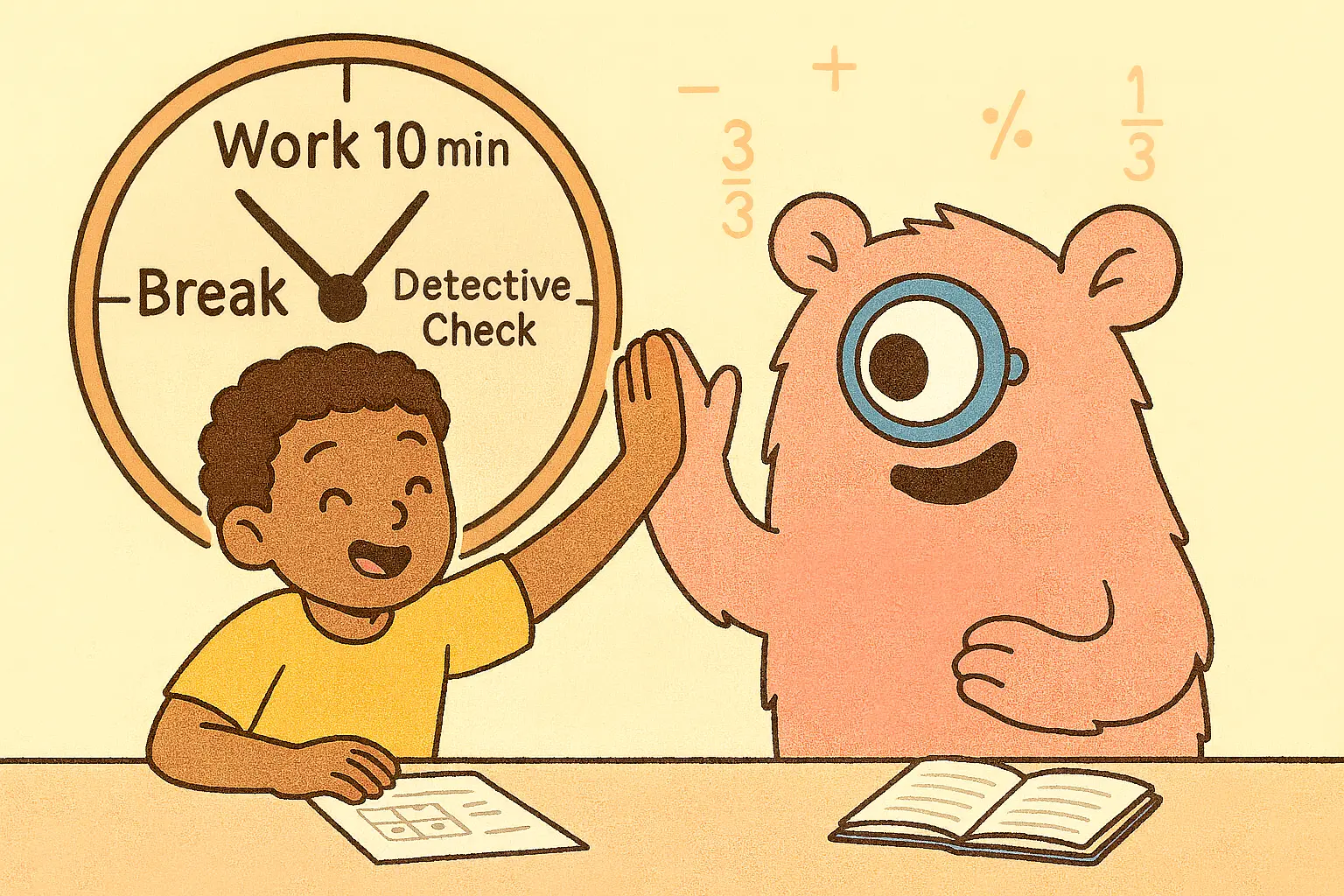6 Ways to Catch “Careless” Math Mistakes in ADHD Learners
TL;DR:What we often call “careless mistakes” are usually attention, working-memory, or error-monitoring challenges - especially for ADHD learners. Slow the start (reduce time pressure), make time and steps visible, use structured page layouts, teach a short “detective” check routine, mix problem types to reduce operation-switch slips, and add brief movement/mental breaks before checking. These simple, repeatable moves catch most slip-ups without shaming.
Parents and teachers: if you’re seeing sign errors, misaligned digits, dropped steps, or answers that don’t make sense, you are not alone. ADHD brains juggle working-memory load and sustained attention differently, which can lead to more slips even when the math idea is understood. For example, children with ADHD often show measurable working-memory differences alongside weaker performance on several math sub-skills, which helps explain why correct thinking can still produce incorrect written answers. They also tend to have differences in error monitoring - the brain’s “uh-oh” signal - which can make it harder to notice and fix mistakes on the fly.

1) Slow the start: reduce time pressure and preview the problem
Many “careless” errors show up when kids rush. Before writing anything, have students do a 10–20-second preview: read the question twice, circle the operation/signs, underline units, and say out loud, “What is this problem really asking?” Reducing time pressure protects working memory and accuracy -especially for anxious or easily distracted learners. In fact, short writing or reflection before timed work has been shown to improve performance under pressure, and math anxiety interacts with working memory in ways that make fast conditions riskier for errors. Giving students a few extra seconds of “wait time” also improves the quality of responses and reasoning.
2) Make steps visible: use micro-checklists and self-explanations
ADHD learners benefit when the “plan” moves out of the head and onto the page. Try a tiny checklist next to each problem: Plan → Compute → Check sign/units → Sense-check. Prompt kids to quickly explain to themselves (or you) why they chose an operation or step. Prompted self-explanation reliably improves mathematical learning and accuracy because it surfaces hidden misunderstandings. Metacognitive questions like “Does this answer make sense?” and “What did I assume?” also sharpen checking accuracy. These tools lower working-memory demands by cognitive offloading, which supports attention and accuracy.
3) Tame layout mistakes: align place value and structure the page
Misaligned digits, dropped carries, or decimal slips are often layout problems, not concept problems. Give learners a consistent page structure: write numbers in clear columns, draw a light place-value frame, and box the decimal point. Research shows that the formatting of arithmetic items and the spacing of symbols affect performance, so a clean, consistent layout can prevent alignment errors.
For word problems, ensure the story’s relationships match the operation - semantic misalignment often drives mistakes.
4) Teach a 60-second “detective check” after each problem
Because ADHD is linked to weaker internal error signals and less post-error slowing, students benefit from an external check routine:
(1) Estimate first/last: “Should the answer be about ___?”
(2) Reverse: check subtraction by addition, division by multiplication.
(3) Units & sign: confirm labels and operation.
This explicit pause helps compensate for error-monitoring differences. A 30–60-second “cool-off” before checking also helps attention recover, since brief mental breaks restore vigilance on sustained tasks.
5) Mix (don’t block) practice to reduce operation-switch slips
Many ADHD learners make “switch errors” (applying yesterday’s operation to today’s problem). Mixing problem types forces active selection of the right strategy and reduces automaticity errors. Interleaved practice - where consecutive questions require different skills - has repeatedly improved math test performance in randomized classroom trials. That matters because adolescents with ADHD show distinct error patterns including more operation-switch mistakes.
6) Build for attention rhythms: work in short bouts, then check
Attention in ADHD fluctuates from minute to minute (increased reaction-time variability), which is a known driver of on-paper slip-ups. Use short, clearly bounded work bursts (e.g., 8–12 minutes), then a micro-break, then do the “detective check.” Also, coach students to trade a bit of speed for accuracy when they notice rushing - ADHD is associated with difficulties optimizing the speed-accuracy balance.

Classroom & home quick-start checklist
- Preview first: read twice, circle operation/sign, underline units.
- Micro-checklist: Plan → Compute → Check sign/units → Sense-check.
- Layout helps: columns for place value, box decimals, margin notes.
- Detective check (60s): Estimate → Reverse → Units/sign.
- Mix it up: interleave problem types to reduce auto-pilot.
- Work–break–check: short bout → micro-break → check routine.
Conclusion
“Careless” mistakes rarely come from a careless kid - they’re usually the by-product of how an ADHD brain handles time, working memory, and error signals. The hopeful part? Small, repeatable supports - previewing the problem, making steps visible, structuring the page, running a 60-second “detective check,” mixing practice, and working in short bouts - add up fast. Try one or two moves tonight, celebrate the effort, and stack the rest over the next few weeks. With your calm coaching and your learner’s growing self-awareness, those red X’s turn into “I can do this.” Slips become data, not a diagnosis - and progress becomes the plan.
Tip: Want a ready-made routine? Print the checklist above and pair it with our neurodivergent-friendly math strategies.
FAQs
Is it really not “carelessness”?
Often no. For many ADHD learners, slips trace back to working-memory load and fluctuating attention, not laziness. That’s why externalizing steps and using a consistent check routine helps.
Should we avoid all timed tasks?
Timed tests can magnify anxiety and sap working memory for some students, increasing errors; brief expressive writing or a calmer, untimed practice format can reduce error risk. You can still use timers positively for work periods and breaks, not to race through problems.
Is talking through steps or using fingers “babyish”?
No. Self-explanation deepens understanding and reduces errors. Early and even older learners may benefit from embodied/visual supports to scaffold accuracy while concepts solidify.
What if my student rushes?
Teach a visible “speed budget”: circle three problems to do slow and correct, then earn a short break. Model trading speed for accuracy - an area where ADHD learners often need coaching on the speed-accuracy balance.
References:
- Ariga, A., & Lleras, A. (2011). Brief and rare mental breaks keep you focused. Cognition. PubMed
- Arnett, A. B., et al. (2021). Reduced error recognition explains post-error slowing differences in ADHD. Journal of Abnormal Psychology. PMC
- Capodieci, A., et al. (2017). Math error types in adolescents with and without ADHD. Frontiers in Psychology. Article
- Closser, A. H., et al. (2024). Symbol spacing and arithmetic performance. Journal of Educational Data Mining. PDF
- Fischer, U., et al. (2020). The implicit contribution of fine motor skills to early mathematics. Frontiers in Psychology. PMC
- Gaye, F., et al. (2023). Working memory and math skills in children with and without ADHD. Neuropsychology. PMC
- Karalunas, S., et al. (2014). Reaction time variability in ADHD: meta-analytic review. Clinical Psychology Review. PubMed
- Lutz, M. C., et al. (2021). Error processing (ERN/Pe) in externalizing psychopathology: meta-analysis. Psychophysiology. PMC
- Michalsky, T., et al. (2024). Metacognitive self-questioning and mathematical literacy. npj Science of Learning. PMC
- Mulder, M. J., et al. (2010). Basic impairments in regulating the speed-accuracy tradeoff in ADHD. Biological Psychiatry. PubMed
- Pellizzoni, S., et al. (2021). Interplay between math anxiety and working memory. Frontiers in Psychology. PMC
- Ramirez, G., & Beilock, S. L. (2011). Expressive writing reduces test anxiety and boosts performance. Science. DOI
- Rhodes, K. T., & Chestnut, E. (2017). Measuring arithmetic: formatting matters. Learning and Instruction. PMC
- Rittle-Johnson, B., & Loehr, A. (2024). Encouraging students to explain ideas in mathematics. Thinking Skills and Creativity. ScienceDirect
- Rohrer, D., et al. (2019). A randomized controlled trial of interleaved mathematics practice. Journal of Educational Psychology. PDF
- Rowe, M. B. (1986). Wait-time: slowing down may be a way of speeding up. Journal of Teacher Education. PDF
- Kofler, M. J., et al. (2013). Reaction time variability in ADHD: review. Neurotherapeutics. PMC
